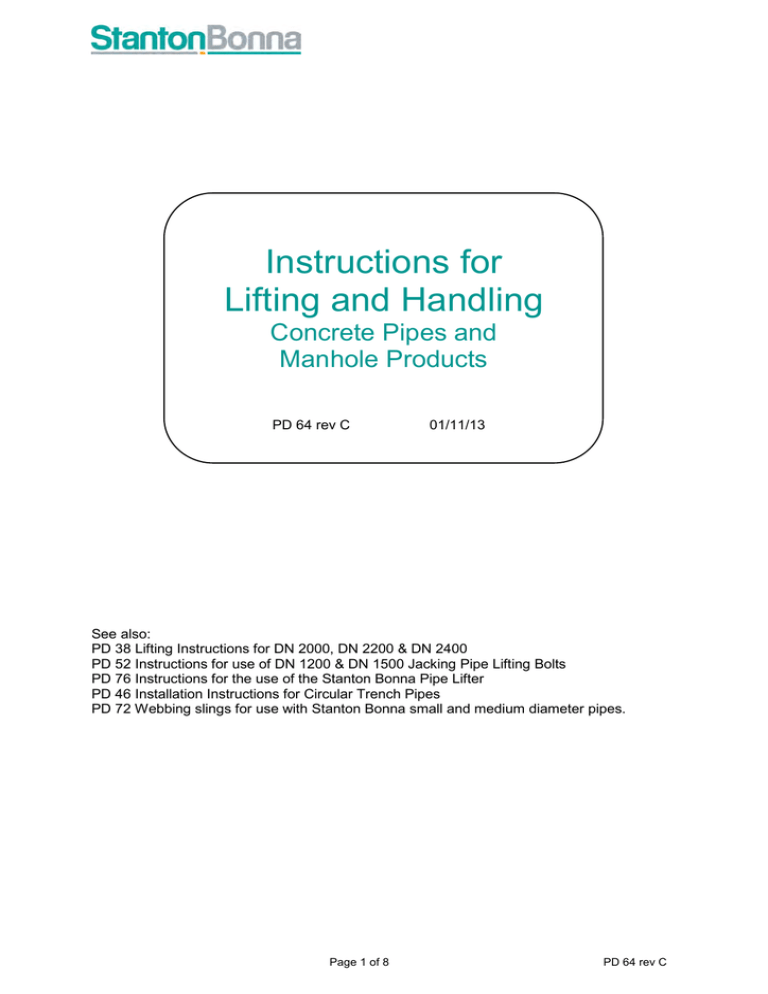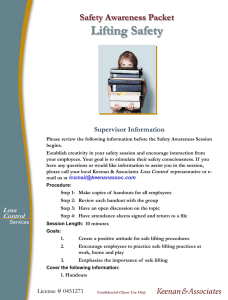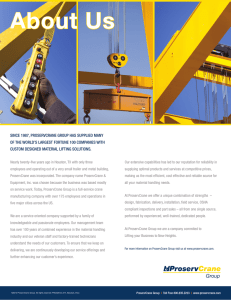
Instructions for
Lifting and Handling
Concrete Pipes and
Manhole Products
PD 64 rev C
01/11/13
See also:
PD 38 Lifting Instructions for DN 2000, DN 2200 & DN 2400
PD 52 Instructions for use of DN 1200 & DN 1500 Jacking Pipe Lifting Bolts
PD 76 Instructions for the use of the Stanton Bonna Pipe Lifter
PD 46 Installation Instructions for Circular Trench Pipes
PD 72 Webbing slings for use with Stanton Bonna small and medium diameter pipes.
Page 1 of 8
PD 64 rev C
Contents
Page No
Circular Pipe Handling
4
Manhole and Cover Slab Handling
7
Concrete Product Weights
8
Page 2 of 8
PD 64 rev C
Scope
This product data sheet contains general information on handling and lifting DN300 –
DN2400 concrete trench pipes together with handling and lifting information on DN900 –
DN3000 traditional manhole rings.
Supplementary information may be found in:•
•
•
•
•
PD 38
PD 52
PD 76
PD 46
PD 72
Lifting instructions for DN2000, DN2200 and DN2400 pipes
DN1200 and DN1500 Jacking pipe lifting eyebolt
Instructions for the use of Stanton Bonna Pipe Lifter
Installation instructions for Integrated Gasket Pipes
Webbing slings for use with Stanton Bonna small and medium
diameter pipes
General
Deliveries are usually made of 28 tonne loads. The receiver is responsible for all off-loading.
Handling operations with chain sets are primarily for off-loading and installing. Units must
not be transported over long distance or on uneven ground, as the increase in dynamic load
and uncontrolled movement of the units is likely to cause damage. If units cannot be offloaded adjacent to where they are needed. Consideration should be given to using a trailer
or pipe lifter (in the case of pipes).
Page 3 of 8
PD 64 rev C
Circular Pipe Handling
Handling and Storage
> Use of correct off-loading equipment on site is essential to ensure a safe, rapid operation
and to avoid damage to pipes.
> For all pipe sizes Stanton Bonna can provide, CE marked Pipe Lifters. See product data
sheet PD72 for further details.
> For lifting DN1400 to DN2400 pipes cast-in anchors are provided for use with lifting
chains.
> For DN300 – DN1200 pipe sizes broad fabric slings may be used.
> Alternatively a properly designed ‘C’ beam bay be used.
> Pipes should not be lifted by chains passed
through the bore.
> Pipes should not be dropped or subjected to
impact
> Where loose gaskets are supplied as with RR
and SG gaskets they must be stored without ties
and protected from sunlight, oil, grease and heat.
Circular Pipes Storage Data
DN
Max. No. of
Layers
300 - 375
4
450 - 600
3
675 - 900
2
Above 900
1
> Full length pipes should be stacked neatly on
level ground on wooden chocks up to the height
stated in the table.
> Rocker pipes may be stored as the top layer of a stall of same size full length pipes or
separating in one layer.
Page 4 of 8
PD 64 rev C
2. Lifting Chains with cast in anchors
The lifting and jointing system, when used in conjunction with pipes DN 1400 and above,
offers these major advantages
Safe Handling
The lifting eyes engage securely and
provide a horizontal lift every time. Once
engaged, the lifting eyes cannot
disengage under load.
Fig. 1
Speed
Off-loading, site handling and pipe
jointing is much faster than with traditional
tackle and no weight balancing is
required.
Cost Effective
Compared to traditional methods, the
speed, safety and pipe laying efficiency of
the system generates savings in time,
plant and labour.
1. The Chain Set
The system comprises lifting anchors
cast into the pipe wall and special three legged chain set (Fig.1) with lifting eyes which
connect to the anchors for lifting and jointing operations.
2. Engaging the eye
To engage a lifting eye with a lifting
anchor simply place the eye opening
over the anchor head and rotate the
eye tail until it touches the pipe surface.
Fig. 2
Fig. 3
Fig. 4
Fig. 5
Correct engagement of the lifting
eyes is essential prior to any lifting
or jointing operation and the spare
lifting eye should be secured to a
shortening clutch to avoid
accidental damage or injury.
3. Correct Lifting
Engage the eye and lift as
shown in Fig. 3
not as in Fig. 4.
5. Disengaging the eye
To disengage a lifting eye, slacken the
chain set and rotate the eye tail away
from the pipe surface until the
eye can be lifted off the
anchor head (Fig. 5).
Page 5 of 8
PD 64 rev C
6. Lifting and Handling
Position the crane's top guide pulley
centrally between the lifting anchors and
engage chain A with the socket end anchor,
B with the spigot end anchor and secure C
to its shortening clutch (Fig. 6). During
lifting the included angle between chains
must not exceed 60°.
Fig. 6
To facilitate off loading DN1400 – DN1800 pipes are fitted with 3No lifting anchors. This
enables the anchor to be presented at a lower level so that the lifting clutches can be
attached without having to climb a ladder from the delivery trailer bed.
Using the Stanton Bonna 3 leg chain set
Attach chain legs B and C to the in-line pair of anchors. The length of leg B and C must be
equalised and the included angle must not greater than 600.
Equalise the length of chains to that of the B and C combination. Attach chain leg A to the
isolated anchor.
The included angle at the master link between leg A and the leg B & C combinations must be
less than 600.
Under no circumstances shall the pipe be lifted from the isolated single anchor alone.
Anchor Recesses
Before backfilling, clean and make good anchor recesses flush to the pipe barrel surface with
epoxy or polyester resin or a 1:3 cement sand mortar proportioned by mass.
Page 6 of 8
PD 64 rev C
General Advice
The Management of Health & Safety at Work Regulations 1999, requires employers to carry
out risk assessment of hazards and to identify the control measures needed to reduce risks
to an acceptable level and comply with other health and safety legislation.
The Lifting Operations and Lifting Equipment Regulations 1998, requires employers to
ensure that all lifting such as the unloading of concrete products are all properly planed by a
competent person, appropriately supervised and carried out in a safe manner.
Users should have a current test certificate and certificate of examination as appropriate and
should check equipment daily for obvious damage before use. If equipment is subjected to
excessive shock load or abuse it should be taken out of use, re-examined and tested.
Junctions, bends, rocker and butt pipes require jointing by traditional methods. Rocker and
butt pipes may be lifted using the single cast in anchor.
Manhole and Cover Slab Handling
> Chamber rings must not be lifted by attached lifting equipment to steps.
> Chamber rings should be lifted with suitable lifting equipment for example chains and
quick release lifting eyes which are available on request.
> Lifting holes are 40mm dia for DN900-1500 chamber rings, 45mm for DN 1800-2100 rings
and 50mm for DN 2400-3000 rings.
> Chains should be attached to lifting eye on the inside of chamber rings and the chain
angle should not exceed 45° to the vertical.
> Chamber rings should be stored vertically to prevent them from rolling or toppling.
> Slabs are manufactured with three lifting eyes and should be lifted level and individually
using suitable three legged chains.
> Slabs should be stored flat, right side up on suitable timber bearers at stack heights not
exceeding those detailed below.
Slab Stacking Data
DN
Max. No. of Slabs per Pack
Storage
Lifting
900 - 1200
5
1
1350 - 1500
3
1
1800
3
1
2100 - 3000
1
1
Lifting Equipment
Quick release lifting eyes and chains are available to
enable rapid handling and jointing of manhole chamber
rings.
All lifting equipment is supplied having been tested in
accordance with the Construction (Lifting Operations)
Regulations 1961.
Page 7 of 8
PD 64 rev C
Concrete Product Weights
Pipes
Nom Dia
Full Length (kg)
Rocker (kg)
300
425
135
375
505
155
450
710
225
525
950
300
600
1215
375
675
1275
650
750
1500
750
800
1650
775
900
2025
925
Nom Dia
Full Length (kg)
Rocker (kg)
1050
2700
1250
1200
3500
1550
1400
4550
2275
1500
5300
2700
1600
5580
2800
1800
7100
3600
2000
8700
-
2200 2400
10400 11200
-
1050
680
1200
875
1350
1025
1500
1215
1800
1730
2100
2185
2400
2700
2700
3350
3000
3950
1050
335
1200
480
1350
655
1500
855
1800
1570
2100
2165
2400
2855
2700
3660
3000
4535
Manholes and Soakaways
Nom Dia
kg/m
900
520
Manholes Cover Slabs
Nom Dia
kg/m
900
220
Manholes Reducing Slabs
Nom Dia
Chamber
kg/m
1200
1350
1500
1800
2100
2400
2700
3000
525
650
850
1575
2175
2900
3875
4350
Corbel and Adjusting Units
Unit Type
Access Size
kg
Adjusting Adjusting Adjusting Adjusting Adjusting
600 x
675 x
750 x
750 x
1200 x
600
675
600
750
675
70
80
125
135
160
Corbel
600 x
600
140
PLEASE NOTE: All weights are approximate. Customer should ensure that lifting
equipment has sufficient capacity to allow for variation.
Right to Change: The specifications given in this document are believed to be correct but are not guaranteed. Stanton Bonna
reserve the right to alter any specifications given in accordance with its policy of continuous product development. All rights
reserved.
Stanton Bonna Concrete Limited Littlewell Lane Stanton-By-Dale Ilkeston Derbyshire DE7 4QW
0ii5 944 i448
0ii5 944 i466
info@stanton-bonna.co.uk
www.stanton-bonna.co.uk
Page 8 of 8
PD 64 rev C


